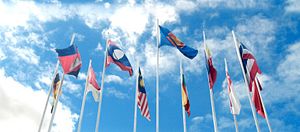On August 8, the Association of Southeast Asian Nations (ASEAN) commemorated its 53rd birthday. The association was established on August 8, 1967 in Bangkok by the five founding member countries of Indonesia, Malaysia, the Philippines, Singapore, and Thailand. Brunei became a member in 1984, Vietnam in 1995, Laos and Myanmar in 1997 and Cambodia in 1999.
The main aims behind the establishment of ASEAN were to promote economic growth, regional peace and stability, active collaboration, and mutual assistance on matters of common interest to all the members. ASEAN also seeks to maintain close and beneficial cooperation with existing regional and international organizations that share common aims and objectives.
ASEAN operates under six fundamental principles, two of which are mutual respect for independence, sovereignty, and territorial integrity, and non-interference in member countries’ internal affairs.
After half a century of existence, ASEAN has made many achievements despite the numerous obstacles it has had to overcome along its journey. The ASEAN bloc has been hailed for its extraordinary role in facilitating and fostering regional and global peace. However, there are significant challenges the 10-nation bloc has to tackle to remain relevant in the regional and international arena.
One of the challenges long faced by ASEAN is the lack of a custodian that can keep the association going. ASEAN also lacks strong institutions to guarantee the success of the implementation of its collective decisions.
Today, the grouping is facing a great challenge amid the strategic competition for influence in the Asia-Pacific between the United States and China. Recently, countries in Southeast Asia have been forced to choose sides. As the U.S. and China increase their strategic rivalry and start a new cold war, ASEAN is locked up in a strategic tug-of-war that could destabilize the whole region, if it fails to navigate the geopolitical challenge effectively.
Moreover, ASEAN countries tend to have divergent interests and priorities. Each member faces their own unique social, economic, and political challenges. As a result, each seems to have no choice but focus on addressing their own internal affairs. This emphasis on domestic affairs will definitely affect the wellbeing of ASEAN as a whole.
ASEAN is not free from internal and external security challenges either. Within the region, there are border disputes and conflicts, illegal migration, ethnic crises, and issues surrounding the life of the dammed Mekong River, which has increasingly made headlines in the last few years.
Outside of the region, there are serious challenges concerning the territorial disputes in the South China Sea and other concerns regarding ASEAN’s role and relevance in the region and beyond.
ASEAN is also constrained by other key challenges, including corruption, demographic changes, uneven social development, disparities in economic development and technology adoption, environmental degradation, and other issues related to politics and the rise of authoritarianism.
Thus, in moving forward, ASEAN must put in extra efforts to sustain and enhance its existing successes and achievements. The bloc has been regarded as a catalyst for peace; therefore, it is vital that ASEAN increase its strengths and step up to promote rule of law in the region.
ASEAN must also promote transparency and work to reduce corruption. At the same time, this association needs to enhance closer coordination and regional connectivity. More collective efforts are required to address the development gap, especially regarding health care, education, technology adoption, and infrastructure development.
More importantly, ASEAN must work hard to enhance the development of good governance, inclusive growth, sustainable development, and democracy, which is in decline. It needs to work together to help less developed members to catch up with others in the region. Closer attention and investment should be placed on the development of the knowledge-based and digital economy.
ASEAN needs to work collaboratively rather than individually, particularly with regard to a regional response to the COVID-19 pandemic. In the face of the COVID-19 storm, it is not the time for ASEAN members to adopt isolationism, protectionism, and nationalism. Rather, ASEAN must support and embrace regionalism and multilateralism by constructively and genuinely working together to achieve common goals and realize the ASEAN Community Vision.
ASEAN also needs to enhance cooperation and coordination as well as proactively engage regional and global powers, especially Australia, China, Japan, India, South Korea, and the United States, to support the realization of its goals and vision as well as to address regional challenges the bloc is facing.
Also important is the need to strike a good balance between commercial gains and environmental protection if ASEAN wishes to achieve inclusive growth and sustainable development. The association must work in unison to tackle critical issues concerning the Mekong River and the disputes in the South China Sea.
Both bilateral and multilateral mechanisms should be pursued and prioritized. The way forward for ASEAN to thrive despite the growing uncertainty in the region and the world is to stay united and resilient. ASEAN needs to uphold a rules-based international order, work to conclude the South China Sea Code of Conduct, and promote the ASEAN Outlook on the Indo-Pacific.
Kimkong Heng is a Ph.D. candidate at the University of Queensland and a Visiting Senior Fellow at the Cambodian Institute for Cooperation and Peace. He is a recipient of the Australia Awards Scholarship. All views expressed are his own.






























